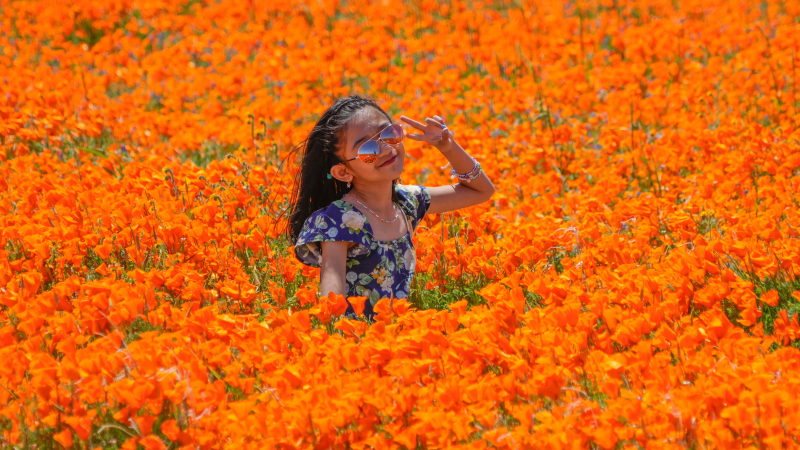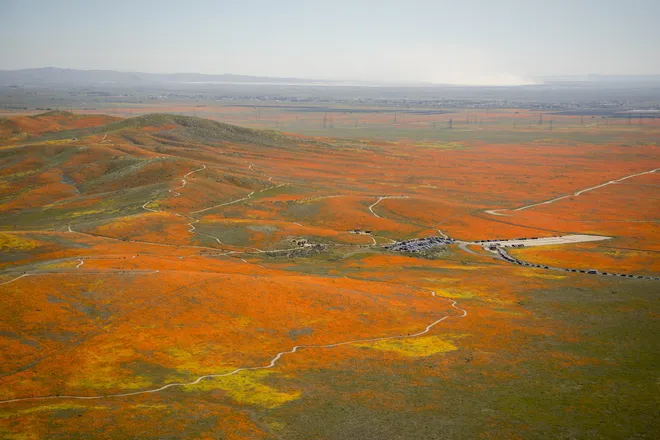Super bloom 2024? California wildflower blooms are shaping up to be spectacular.
The West has seen months of torrential rains, flooding and mudslides. Now the rainbow comes: red, blue, purple and golden flowers covering mile upon mile of wildland with colors so vivid that they could be seen from space last year.
The show is expected to draw crowds as the floral kaleidoscope sweeps up from South to North with the coming spring.
Wildflower blooms are usually especially stunning after a wet winter in the frequently dry West. Because last year was also a rainy year, this year's bloom could be even more spectacular — what's colloquially often called a "superbloom."
“Things are pointing to a good bloom year,” said Dan McCamish, natural resources manager with the Colorado Desert District of the California State Parks.
While it’s impossible to say 100% that there will be a big year for the desert to flower, the chances are high, said McCamish.
He’s been compiling rainfall totals over the last 11 years. So far three of those have had extremely above-average precipitation – 2016/2017, 2019/2020 and 2023/2024.

“In the previous two years where we have been so high above our rain average total, we have had an outstanding bloom, where we have seen those carpets of flowers,” he said.
Some areas of the Anza-Borrego Desert State Park have already begun to boom. The park has created an interactive map for visitors.
“We're just starting the kick-off of the winter annual flower season and I expect it will run to the beginning of April,” he said.
Blooming wildflowers could include lupine, coreopsis, desert sunflowers, evening or brown-eyed primroses, desert bells, desert poppies and desert lilies, according to the California State Parks.
The phenomenon occurs across the West, in Arizona, New Mexico, and up and down California. But the largest areas tend to be in the southern part of the state, in places like Death Valley, the Carrizo Plain and Antelope Valley. (In Death Valley, the National Park Service said last month they were expecting a good bloom, but not quite a "superbloom.")

Not every area will bloom — it depends on how much rain it got in the last year.
Areas where superblooms occur are often dry areas where plant species are primed to take advantage of wet conditions where the land suddenly become lush and fertile. If things stay dry, their seeds remain dormant, opting out of germinating. But when a wet year comes and then the soil warms, they burst forth in a dazzling display, growing blooming, spreading their seeds in an explosion of life before quickly dying when the hot, dry summer makes the soil inhospitable again.
The blooms typically begin in mid-March and run into May and sometimes June. To find the best viewing areas, the California Department of Parks and Recreation has a page online that covers what's blooming and where.
Don't doom the bloom
To protect the fragile lands where the flowering take place, it's important to stay on designated trails, avoid trampling the plants and only take pictures – picking the flowers is not only prohibited but means they can’t set seed to bloom again.
"We say, 'Don't Doom the Bloom,'" McCamish said. “These are very fragile flowers and ecosystems."
Too often when visitors visit an area of especially strong bloom, they crowd the roadways, sometimes stopping and leaving their cars to take photos, walking into fields and crushing the very thing they’ve come to see.
At times officials have had to close off hiking trails and areas of especially strong bloom because the crowds were doing so much damage to delicate wildland areas. They've even handed out fines and threatened those harming areas with arrest.
Even when they're open, park officials caution that many areas where the blooms are happening are remote. Cell coverage can be spotty or non-existent and GPS may not work. When it does, it might be on dirt roads that require 4-wheel drive vehicles.
It’s imperative that visitors help protect the plants so they can live to make more flowers in the future, said McCamish.
“These are very fragile flowers and ecosystems,” he said. “Be mindful of where you step, try to avoid stepping on the plants and the flowers.”
Disclaimer: The copyright of this article belongs to the original author. Reposting this article is solely for the purpose of information dissemination and does not constitute any investment advice. If there is any infringement, please contact us immediately. We will make corrections or deletions as necessary. Thank you.





